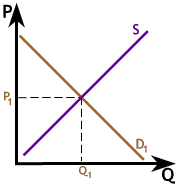


 On the other hand, what makes the item desirable may not be the price, but the
perceived price. Suppose the graph to the right, illustrates the market
for Rolex® watches with ruby encrusted bezels. Suppose D1 is the demand curve, if most people think these are $150,000 items. D2 is the demand curve when people believe they cost $300,000. A change in the perception of what such watches
cost leads to a shift from D1 to D2, leading to a higher price. However, for a given perception of the price, the demand curve could still be downward sloping.
If this is how it works, if buyers of ruby studded Rolex® watches
still want the best deal, then this isn't an exception to the law of
demand at all.
On the other hand, what makes the item desirable may not be the price, but the
perceived price. Suppose the graph to the right, illustrates the market
for Rolex® watches with ruby encrusted bezels. Suppose D1 is the demand curve, if most people think these are $150,000 items. D2 is the demand curve when people believe they cost $300,000. A change in the perception of what such watches
cost leads to a shift from D1 to D2, leading to a higher price. However, for a given perception of the price, the demand curve could still be downward sloping.
If this is how it works, if buyers of ruby studded Rolex® watches
still want the best deal, then this isn't an exception to the law of
demand at all.


Copyright © 1995-2004 OnLineTexts.com, Inc. - All Rights Reserved
 On the other hand, what makes the item desirable may not be the price, but the
perceived price. Suppose the graph to the right, illustrates the market
for Rolex® watches with ruby encrusted bezels. Suppose D1 is the demand curve, if most people think these are $150,000 items. D2 is the demand curve when people believe they cost $300,000. A change in the perception of what such watches
cost leads to a shift from D1 to D2, leading to a higher price. However, for a given perception of the price, the demand curve could still be downward sloping.
If this is how it works, if buyers of ruby studded Rolex® watches
still want the best deal, then this isn't an exception to the law of
demand at all.
On the other hand, what makes the item desirable may not be the price, but the
perceived price. Suppose the graph to the right, illustrates the market
for Rolex® watches with ruby encrusted bezels. Suppose D1 is the demand curve, if most people think these are $150,000 items. D2 is the demand curve when people believe they cost $300,000. A change in the perception of what such watches
cost leads to a shift from D1 to D2, leading to a higher price. However, for a given perception of the price, the demand curve could still be downward sloping.
If this is how it works, if buyers of ruby studded Rolex® watches
still want the best deal, then this isn't an exception to the law of
demand at all. 
